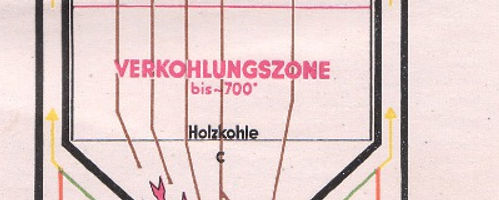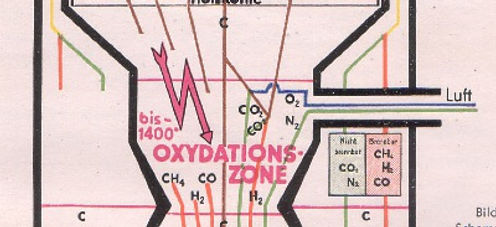Gas generator function and chemistry
The propaganda movie with the romantic music does not show the truth. The forced laborers' only choice was to smile at the camera, otherwise they were shot. Wood gasifiers and gas generators are witnesses to an unimaginable hardship, and this must not be forgotten. Please treat the historical facilities with respect if you find them. Don't mutilate them for tinkering, which usually ends up in a mess and the contemporary witnesses in the scrapyard.
Mobile gas generators were originally designed for the use of charcoal. At the urging of France, the development of wood gasifiers was accelerated. Germany had the largest number of gas generators due to the shortage of fuel caused by the war. The most readily available domestic fuel was and is lignite, the latest fossil phase of wood (wood - peat - lignite - hard coal - anthracite). During WW2, most gas generators were therefore powered by lignite.
While wood and peat were mainly used in Switzerland, charcoal was widely used in France. In Germany, on the other hand, charcoal was valuable and rare. For this reason, wood was prescribed in agriculture, otherwise lignite was the most important fuel. Depending on availability, anthracite and smouldering coke were also gasified in special types of generators.
So-called descending gasifiers can be operated with the three bituminous fuels wood, peat and lignite. All descending gasifier types are popularly known as wood gas generators or wood gasifiers. To explain the processes in the gas generator, I refer to the Imbert system. This is historically the best documented and can be described as the model for all later gas generators.

The mobile gas generator is a suction gas system because the engine draws in the required amount of gas. Initially, a fan takes over the function of the engine and draws air through the entire system. A flame is held at the inlet hole of the gas generator and the suction effect draws the flame into the hearth, thereby fanning the generator.
After 6 to 10 minutes, the gas can be ignited at the fan outlet. If the flame sits calmly on the outlet pipe and burns reddish-blue and evenly, the fan is switched off and the fan valve is closed. By actuating the starter, the air throttle valve is slowly opened until an ignitable gas mixture is produced and the engine starts.
Sometimes the gas gets worse shortly after starting. This so-called gas hole is overcome by means of full throttle and a less open air flap, after which the vehicle is ready for operation. If the engine stops at this moment, it must first be ventilated for a few minutes and then the starting process repeated.

Downdraft gasifier
Schematic diagram
The incoming air is distributed into the hearth through nozzles. In the vicinity of the nozzles, i.e. in the oxidation zone, the previously ignited charcoal gasifies with the incoming air.
On the one hand, combustible carbon monoxide CO is produced. On the other hand, non-combustible carbon dioxide CO2 is also produced.
The CO2 is reduced to carbon monoxide CO in the glowing charcoal (catalyst) below the hearth. Fuel can be added via the lid of the generator.
Drying zone:
The water in the wood evaporates at approx. 170° due to the heat rising from the stove.

Smoldering zone:
The wood carbonizes at approx. 500°. This produces wood vinegar (acetic acid and methane) and wood tar in a gaseous state.

Charring zone:
At approx. 700° the wood is converted into charcoal.

Oxidation zone:
The charcoal is oxidized at up to approx. 1400°, producing CO and CO2. The resulting heat keeps the process going. Water vapor (H2O) splits into hydrogen (H2) and oxygen (O). Wood vinegar or acetic acid is converted to methane (CH4). Finally, the wood tar (long C+H+O molecules) is cracked into more volatile components. The hearth between the oxidation and reduction zones is conical, so that a high-temperature zone is formed in all load states.

Reduction zone:
Glowing charcoal is highly reactive, it is the catalyst of the system. At approx. 500°C, 1 carbon dioxide molecule (CO2) is reduced to two carbon monoxide molecules (CO). The oxygen combines with the glowing coal and also forms carbon monoxide (CO). Tar components (consisting of long C+H+O molecules) are converted to CO and H2 in several steps.
The resulting gas mixture is called wood gas or generator gas and is a lean gas. After the gas is produced, the dirt carried along is filtered and the hot gas is cooled to increase the density and therefore the output.
A reduction zone can only be formed with hardwood. This means that only wood that forms charcoal is suitable as fuel. A good reduction zone cannot form if the percentage of softwood is too high, if there is too much bark and sawdust, or if the material is fine (small wood chips). The gas quality is poor and the tar is not broken down; it condenses in the engine and clogs the valves and pistons.
In the language of the chemist, the process can be expressed as follows:
Oxidation
C + O2 = CO2 (heat-generating)
Hydrogen formation
CO + H2O = CO2 + H2 (slightly heat-generating)
C + H2O = CO + H2 (heat consuming)
Reduction
CO2 + C = CO + CO (heat-consuming)
The average composition of the gas is as follows:
Carbon monoxide CO 23%
Hydrogen H2 18%
Methane CH4 2-4%
Carbon dioxide CO2 10%
Nitrogen N2 47%
The lower calorific value is 1200 - 1400 kcal/m³ (5000-5800 kJ/m³). The air requirement for combustion in the engine is approx. 1.0 - 1.2. The mixture calorific value is therefore approx. 600-650 kcal/m³ (2500-2700 kJ/m³). The power loss compared to gasoline (approx. 900 kcal/m³) is therefore 28-35%. A further drop in performance can result from the lower filling level of the engine (flow resistance in the generator) and the slower combustion of the generator gas compared to gasoline.
As a countermeasure, the engines were more highly compressed or supercharged, and ignition took place 10-15° earlier, usually manually. In addition, most systems had pressure gauges so that it was possible to react in a timely manner if the filters or the stove began to clog. Due to the characteristics of wood gas, the most economical operation is with a large-volume, slow-running gasoline engine (see Ford Model A with wood gasifier).
1 liter of petrol corresponds to
approx. 2.5 - 3.0 kg hardwood
approx. 3.0 - 3.5 kg peat (preliminary stage of fossil coal)
approx. 1.5 - 2.0 kg lignite (also known as Union briquettes)